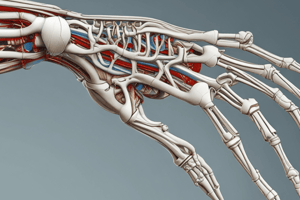Podcast
Questions and Answers
What is the primary function of the synovial fluid in synovial joints?
What is the primary function of the synovial fluid in synovial joints?
- To provide structural support to the joint
- To absorb shock during high-impact activities
- To act as a medium for communication between cells
- To allow smooth and easy movement between joint parts (correct)
Where is the synovial membrane located?
Where is the synovial membrane located?
- Within the joint capsule (correct)
- Between the ligaments and tendons
- Outside of the cartilage layer
- Above the epiphysis of the bone
What is the role of the capsule in synovial joints?
What is the role of the capsule in synovial joints?
- To facilitate blood flow to the joint
- To enclose and protect the synovial membrane and fluid (correct)
- To connect muscles to the bone
- To produce collagen fibers for stability
Synovial fluid is most accurately described as which of the following?
Synovial fluid is most accurately described as which of the following?
Which component is essential for the lubrication and nourishment of synovial joints?
Which component is essential for the lubrication and nourishment of synovial joints?
Which statement accurately describes the relationship between bones in the body?
Which statement accurately describes the relationship between bones in the body?
What is the primary function of the joints formed by the connections of bones?
What is the primary function of the joints formed by the connections of bones?
Which of the following best explains the term 'joint' in the context of bone connections?
Which of the following best explains the term 'joint' in the context of bone connections?
Which feature is common to all joints formed by bone connections?
Which feature is common to all joints formed by bone connections?
What conclusion can be drawn from the fact that every bone is connected to others?
What conclusion can be drawn from the fact that every bone is connected to others?
What is the classification of synovial joints based on?
What is the classification of synovial joints based on?
Which of the following is NOT a recognized type of synovial joint shape?
Which of the following is NOT a recognized type of synovial joint shape?
How many types of synovial joint shapes are provided in the classification mentioned?
How many types of synovial joint shapes are provided in the classification mentioned?
Which type of synovial joint allows for rotation around a single axis?
Which type of synovial joint allows for rotation around a single axis?
What characteristic of a synovial joint is specifically associated with the plane type?
What characteristic of a synovial joint is specifically associated with the plane type?
What is the primary role of fluid in a joint?
What is the primary role of fluid in a joint?
Where is the fluid that lubricates the joint contained?
Where is the fluid that lubricates the joint contained?
Which statement best describes the function of the joint fluid?
Which statement best describes the function of the joint fluid?
What might occur if the fluid in a joint becomes insufficient?
What might occur if the fluid in a joint becomes insufficient?
What is a consequence of effective joint lubrication?
What is a consequence of effective joint lubrication?
What function allows the skeleton to support gross movement?
What function allows the skeleton to support gross movement?
What is the primary characteristic of a fibrous joint?
What is the primary characteristic of a fibrous joint?
Which type of joint is characterized by the presence of a synovial cavity?
Which type of joint is characterized by the presence of a synovial cavity?
What tissue primarily connects the bones in fibrous joints?
What tissue primarily connects the bones in fibrous joints?
Which classification of joint does not allow for movement?
Which classification of joint does not allow for movement?
Which of the following is NOT a type of fibrous joint?
Which of the following is NOT a type of fibrous joint?
What is the main role of the synovial cavity in joints?
What is the main role of the synovial cavity in joints?
Cartilaginous joints are primarily characterized by what feature?
Cartilaginous joints are primarily characterized by what feature?
Flashcards are hidden until you start studying
Study Notes
Joint Structure and Function
- Every bone in the body is connected to form a joint.
- Joints are lubricated by fluid, enabling smooth movement of parts against each other.
- Synovial fluid is contained within the synovial capsule which holds the fluid in place.
- The synovial membrane, located inside the capsule, is responsible for producing synovial fluid.
Components of Synovial Joints
- Articular cartilage is present in synovial joints and provides a smooth surface for interaction.
- Synovial joints allow for greater flexibility and movement due to their design.
Classification of Synovial Joints
- Synovial joints can be classified according to the shape of their articular surfaces:
- Plane joints
- Hinge joints
- Pivot joints
- Condylar joints
- These joints facilitate gross movement and enable bone growth.
Functions of Joints
- Joints connect and support the bones in the body.
- They provide flexibility, allowing for movement.
- Joints allow for bone growth during development.
Classification of Joints
- Joints can be structurally classified based on the tissue connecting the bones:
- Fibrous joints: Immobile, without a synovial cavity.
- Cartilaginous joints: Also without a synovial cavity but allow limited movement.
- Synovial joints: Highly mobile, characterized by the presence of a synovial cavity.
Fibrous Joints
- Connected by dense connective tissue primarily made of collagen.
- They are further categorized into three types, with each type having its specific characteristics related to movement and structure.
Studying That Suits You
Use AI to generate personalized quizzes and flashcards to suit your learning preferences.




